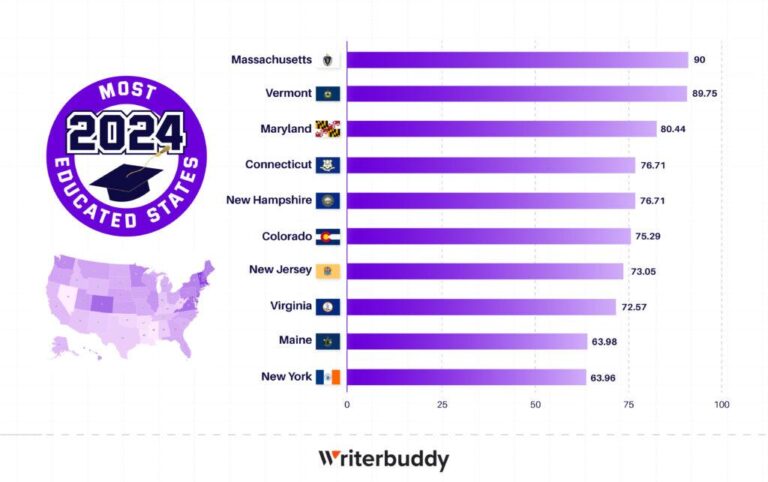Top U.S. States Excelling in Educational Attainment: Trends, Drivers, and Economic Impact
In today’s economy, education plays a pivotal role in shaping career opportunities and social advancement. Identifying which states lead in educational achievement is crucial for policymakers, educators, and communities striving to enhance economic prosperity and quality of life. Utilizing the most recent data from USAFacts, this article explores the states with the highest educational attainment rates, examines the underlying factors contributing to their success, and discusses the broader economic and societal benefits of a well-educated population.
Leading States in Higher Education: A Closer Look
Certain states consistently rank at the forefront when it comes to the percentage of adults holding bachelor’s degrees or higher. These states not only have a strong academic culture but also prioritize investments in educational infrastructure and workforce readiness. For instance, Massachusetts, Maryland, and Colorado stand out for their impressive educational attainment rates, reflecting their dedication to nurturing environments where learning and innovation flourish.
Common characteristics of these top-performing states include:
- Extensive and diverse public university networks attracting students nationwide
- Generous funding for academic research and scholarship programs
- Collaborative partnerships between industries and educational institutions
- Comprehensive student support systems, from enrollment through graduation
| State | Percentage of Adults with Bachelor’s or Higher | Notable Universities |
|---|---|---|
| Massachusetts | 49.3% | Harvard University, MIT, Boston University |
| Maryland | 44.7% | Johns Hopkins University, University of Maryland |
| Colorado | 43.2% | University of Colorado Boulder, Colorado State University |
| Virginia | 42.8% | University of Virginia, Virginia Tech |
| New Jersey | 41.5% | Rutgers University, Princeton University |
Core Elements Fueling Educational Excellence in Top States
The success of states with high educational attainment is often the result of deliberate strategies and community collaboration. Equitable distribution of educational funding ensures that schools serving disadvantaged populations receive adequate resources, helping to close achievement gaps. Early childhood education programs are another cornerstone, providing young learners with a strong academic foundation that supports lifelong learning.
Additionally, these states benefit from well-established public universities and vocational training centers, offering multiple pathways for students to succeed beyond high school. The synergy between educators, families, and local governments fosters environments conducive to continuous educational improvement. Key initiatives include:
- Comprehensive teacher development and retention efforts that improve classroom instruction quality
- Active community involvement that supports student services and extracurricular activities
- Data-informed decision-making to refine curricula and allocate resources efficiently
- Integration of advanced technology in classrooms to enhance learning experiences
| Factor | Level of Influence | Representative State |
|---|---|---|
| Early Childhood Education | High | Massachusetts |
| Teacher Retention | Moderate | New Jersey |
| Community Engagement | High | Washington |
| Technology Access | Moderate | California |
How Educational Attainment Spurs Economic Growth and Enhances Community Life
Higher education levels correlate strongly with economic vitality. States with a larger share of college-educated adults tend to experience accelerated economic expansion, driven by a skilled workforce capable of innovation and attracting diverse industries. Studies reveal that these states enjoy lower unemployment rates and higher average incomes, which in turn contribute to improved living standards.
Beyond economic metrics, education fosters social benefits such as increased civic participation, reduced crime, and better public health. Communities with well-educated residents often demonstrate stronger social cohesion and leadership. Key advantages linked to higher education include:
- Greater workforce flexibility in adapting to technological advancements and market shifts
- Elevated levels of volunteerism and community leadership
- Enhanced capacity for sustainable and inclusive development
| Education Level | Economic Contribution | Community Impact |
|---|---|---|
| Bachelor’s Degree or Higher | Approximately 20% higher GDP per capita | Significantly lower crime rates |
| Some College | Moderate income growth | Increased civic engagement |
| High School Diploma | Baseline economic contribution | Basic community stability |
Strategies to Enhance Educational Outcomes Nationwide
To raise educational achievement across the country, policymakers must focus on equitable resource distribution, ensuring that schools in underserved areas receive the support necessary to thrive. Investments in cutting-edge classroom technology, comprehensive teacher training, and expanded early learning programs have proven effective in boosting student engagement and academic success. States implementing these approaches report notable gains in literacy, graduation rates, and college readiness.
Furthermore, fostering strong partnerships between schools, local businesses, and nonprofit organizations can enrich educational experiences. These collaborations create mentorship opportunities and practical learning environments that prepare students for the workforce. Adopting flexible curricula that blend career and technical education with traditional academics equips students with diverse skills aligned with evolving economic needs.
Final Thoughts: The Road Ahead for Educational Excellence
USAFacts’ latest data highlights the states leading the nation in educational attainment, revealing important regional patterns and the impact of targeted policies and investments. As the educational landscape evolves, understanding which states prioritize learning is vital for guiding future decisions by policymakers, educators, and communities. Monitoring these trends will remain essential for fostering sustained economic growth and social well-being across the United States.







